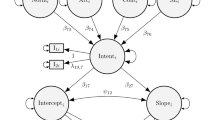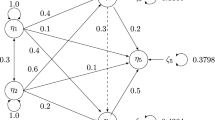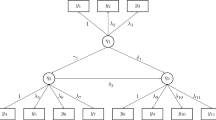Abstract
Recently, it has been recognized that the commonly used linear structural equation model is inadequate to deal with some complicated substantive theory. A new nonlinear structural equation model with fixed covariates is proposed in this article. A procedure, which utilizes the powerful path sampling for computing the Bayes factor, is developed for model comparison. In the implementation, the required random observations are simulated via a hybrid algorithm that combines the Gibbs sampler and the Metropolis-Hastings algorithm. It is shown that the proposed procedure is efficient and flexible; and it produces Bayesian estimates of the parameters, latent variables, and their highest posterior density intervals as by-products. Empirical performances of the proposed procedure such as sensitivity to prior inputs are illustrated by a simulation study and a real example.
Similar content being viewed by others
References
Albert, J.H., & Chib, S. (1993). Bayesian analysis of binary and polychotomous response data.Journal of the American Statistical Association, 88, 669–679.
Arminger, G., & Muthén, B.O. (1998). A Bayesian approach to nonlinear latent variable models using the Gibbs sampler and the Metropolis-Hastings algorithm.Psychometrika, 63, 271–300.
Bagozzi, R.P., Baumgartner, H., & Yi, Y. (1992). State versus action orientation and the theory of reasoned action: An application to coupon usage.Journal of Consumer Research, 18, 505–517.
Bayarri, M.J., & Berger, J.O. (2000). P values for composite null models.Journal of the American Statistical Association, 95, 1127–1142.
Bentler, P.M. (1983). Some contributions to efficient statistics for structural models: Specification and estimation of moment structures.Psychometrika, 48, 493–517.
Bentler, P.M. (1992).EQS: Structural equation program manual. Los Angeles, CA: BMDP Statistical Software.
Bentler, P.M., & Dudgeon, P. (1996). Covariance structure analysis: Statistical practice, theory and direction.Annual Review of Psychology, 47, 541–570.
Berger, J.O. (1985)Statistical decision theory and Bayesian analysis. New York, NY: Springer-Verlag.
Bollen, K.A. & Long, J.S. (1993).Testing structural equation models. Newbury Park, CA: Sage.
Bollen, K.A., & Paxton, P. (1998). Two-stage least squares estimation of interaction effects. In R.E. Schumacker & G.A. Marcoulides (Eds.),Interaction and nonlinear effects in structural equation models (pp. 125–151). Mahwah, NJ: Lawrence Erlbaum Associates.
Broemeling, L.D. (1985).Bayesian analysis of linear models. New York, NY: Marcel Dekker.
Browne, M.W. (1984). A symptotic distribution-free methods for the analysis of covariance structures.British Journal of Mathematical and Statistical Psychology, 37, 62–83.
Busemeyer, J.R., & Jones, L.E. (1983). Analysis of multiplicative combination rules when the causal variables are measured with error.Psychological Bulletin, 93, 549–562.
Carlin, B.P., & Louis, T.A. (1996).Bayes and Empirical Bayes Methods for Data Analysis. Chapman and Hall.
Casella, G. & Berger, R.L. (1990).Statistical inference. Belmont, CA: Duxbury Press.
Chen, M.H., & Shao, Q.M. (1999). Monte Carlo estimation of Bayesian credible and HPD intervals.Journal of Computational and Graphical Statistics, 8, 69–92.
Chen, M.H., Shao, Q.M., & Ibrahim, J.G. (2000).Monte Carlo methods in Bayesian computation. New York, NY: Springer.
Chib, S. (1995). Marginal likelihood from the Gibbs output.Journal of the American Statistical Association, 90, 1313–1321.
DiCiccio, T.J., Kass, R.E., Raftery, A., & Wasserman, L. (1997). Computing Bayes factors by combining simulation and asymptotic approximations.Journal of the American Statistical Association, 92, 903–915.
Dunson, D.B. (2000). Bayesian latent variable models for clustered mixed outcomes.Journal of the Royal Statistical Society, Series B,62, 355–366.
Everitt, B.S. (1984).An introduction to latent variable models. London: Chapman and Hall.
Gelfand, A.E., & Dey, D.K. (1994). Bayesian model choice: Asymptotic and exact calculations.Journal of the Royal Statistical Society, Series B,56, 501–514.
Gelman, A., & Meng, X. L. (1998). Simulating normalizing constant: From importance sampling to bridge sampling to path sampling.Statistical Science, 13, 163–185.
Gelman, A. & Rubin, D.B. (1992). Inference from iterative simulation using multiple sequence (with discussion).Statistical Science, 7, 457–472.
Gelman, A., Meng, X.L., & Stern, H (1996). Posterior predictive assessment of model fitness via realized discrepancies.Statistica Sinica, 6, 733–807.
Gelman, A., Roberts, G.O., & Gilks, W.R. (1995). Efficient Metropolis jumping rules. In J.M. Bernardo, J.O. Berger, A.P. Dawid & A.F.M. Smith (Eds.),Bayesian statistics 5 (pp. 599–607). Oxford, U.K.: Oxford University Press.
Geman, S., & Geman, D. (1984). Stochastic relaxation, Gibbs distributions, and the Bayesian restoration of images.IEEE Transactions on Pattern Analysis and Machine Intelligence, 6, 721–741.
Hastings, W.K. (1970). Monte Carlo sampling methods using Markov chains and their application.Biometrika, 57, 97–100.
Hu, L., Bentler, P.M., & Kano, Y. (1992). Can test statistics in covariance structure analysis be tested?Psychological Bulletin, 112, 351–362.
Jaccard, J., & Wan, C.K. (1995). Measurement error in the analysis of interaction effects between continuous predictors using multiple regression: Multiple indicator and structural equation approaches.Psychological Bulletin, 117, 348–357.
Jonsson, F.Y. (1998). Modeling interaction and nonlinear effects: A step by step LISREL example. In R.E. Schumacker & G.A. MarcoulidesInteraction and nonlinear effects in structural equation models (Eds.), (pp. 17–42). Mahwah, NJ: Lawrence Erlbaum Associates.
Jöreskog, K.G. & Sörbom, D. (1996).LISREL 8: Structural Equation modeling with the SIMPLIS command language. Scientific Software International: Hove and London.
Kass, R.E., & Raftery, A.E. (1995). Bayes Factors.Journal of the American Statistical Association, 90, 773–795.
Kenny, D.A., & Judd, C.M. (1984). Estimating the nonlinear and interactive effects of latent variables.Psychological Bulletin, 96, 201–210.
Lee, S.Y., & Song, X.Y. (2001). Hypothesis testing and model comparison in two-level structured equation models.Multivariate Behavioral Research, 36, 639–655.
Lee, S.Y., & Zhu, H.T. (2000). Statistical analysis of nonlinear structural equation models with continuous and polytomous data.British Journal of Mathematical and Statistical Psychology, 53, 209–232.
Lee, S.Y., & Zhu, H.T. (2002). Maximum likelihood estimation of nonlinear structural equation models.Psychometrika, 189–210.
Lempers, F.B. (1971).Posterior probabilities of alternative linear models. Rotterdam: University of Rotterdam Press.
Legler, J.M., & Ryan, L.M. (1997). Latent variable models for teratogenesis using multiple binary outcomes.Journal of the American Statistical Association, 92, 13–20.
Lewis, S.M., & Raftery, A.E. (1997). Estimating Bayes factors via posterior simulation with Laplace-Metropolis estimator.Journal of the American Statistical Association, 92, 648–663.
Lindley, D.V. & Smith, A.F.M. (1972). Bayes estimates for the linear model (with discussion).Journal of the Royal Statistical Society, Series B,34, 1–42.
Meng, X.L. (1994). Posterior predictivep-values.The Annals of Statistics, 22, 1142–1160.
Meng, X.L., & Schilling, S. (1996). Fitting full-information item factor models and an empirical investigation of bridge sampling.Journal of the American Statistical Association, 91, 1254–1267.
Meng, X.L., & Wong, W.H. (1996). Simulating ratios of normalizing constants via a simple identity: A theoretical exploration.Statistica Sinica, 6, 831–860.
Metropolis, N., Rosenbluth, A.W., Rosenbluth, M.N., Teller, A.H., & Teller, E. (1953). Equations of state calculations by fast computing machine.Journal of Chemical Physics, 21, 1087–1091.
Ogata, Y. (1989). A Monte Carlo method for high dimensional integration.Numerische Mathematik, 55, 137–157.
Ogata, Y. (1990). A Monte Carlo method for an objective Bayesian procedure.Annals of the Institute of Statistical Mathematics, 42, 403–433.
Ping, R.A. (1996). Latent variable regression: A technique for estimating interaction and quadratic coefficients.Multivariate Behavioral Research, 31, 95–120.
Raftery, A.E. (1993). Bayesian model selection in structural equation models. In K.A. Bollen & J.S. Long (Eds.),Testing structural equation models (pp. 163–180). Thousand Oaks, CA: Sage Publications.
Raftery, A.E. (1996). Hypothesis testing and model selection. In W.R. Wilks, S. Richardson & D.J. Spieglhalter (Eds.),Practical Markov Chain Monte Carlo (pp. 163–188). London: Chapman and Hall.
Richardson, S., & Green, P.J. (1997). On Bayesian analysis of mixture with an unknown number of components (with discussion).Journal of the Royal Statistical Society, Series B,59, 731–792.
Rubin, D.B. (1984). Bayesianly justifiable and relevant frequency calculation for the applied statistician.The Annals of Statistics, 12, 1151–1172.
Sammel, M.D., & Ryan, L.M. (1996). Latent variables with fixed effects.Biometrics, 52, 220–243.
Sammel, M.D., Ryan, L.M., & Legler, J.M. (1997). Latent variable models for mixed discrete and continuous outcomes.Journal of the Royal Statistical Society, Series B,59, 667–678.
Schwarz, G. (1978). Estimating the dimension of a model.The Annals of Statistics, 6, 461–464.
Schumacker, R.E., & Marcoulides, G.A. (1998).Interaction and Nonlinear Effects in Structural Equation Models. Mahwah, NJ: Lawrence Erlbaum Associates.
Shi, J.Q., & Lee, S.Y. (2000). Latent variable models with mixed continuous and polytomous data.Journal of the Royal Statistical Society, Series B,62, 77–87.
Song, X.Y., & Lee, S.Y. (2001). Bayesian estimation and test for factor analysis model with continuous and polytomous data in several populations.British Journal of Mathematical and Statistical Psychology, 54, 237–263.
Song, X.Y., & Lee, S.Y. (2002). Bayesian estimation and model selection of multivariate linear model with polytomous variables.Multivariate Behavior Research, 37, 453–477.
Spiegelhalter, D.J. & Smith, A.F.M. (1982). Bayes factor for linear and log-linear models with vague prior information.Journal of the Royal Statistical Society, Series B,44, 377–387.
Tanner, M., & Wong, W.H. (1987). The calculation of posterior distribution by data augmentation (with discussion).Journal of the American Statistical Association, 82 528–550.
Tierney, L. & Kadane, J.B. (1986). A accurate approximations for posterior moments and marginal densities.Journal of the American Statistical Association, 81, 82–86.
World Values Survey: 1981–1984 & 1990–1993. (1994). ICPSR version. Ann Arbor, MI: Institute for Social Research [producer], 1994. Ann Arbon, MI: Inter-University Consortium for Political and Social Research [distributor]. (For the I.C.P.S.R. version the Institute for Social Research is the producer, and the Inter-University Consortium of Political and Social Research is the distributor.)
Yuan, K.E., & Bentler, P.M. (1997). Mean and covariance structures analysis: The oretical and practical improvements.Journal of the American Statistical Association, 92, 767–774.
Zhu, H.T., & Lee, S.Y. (1999). Statistical analysis of nonlinear factor analysis models.British Journal of Mathematical and Statistical Psychology, 52, 225–242.
Author information
Authors and Affiliations
Corresponding author
Additional information
This research is fully supported by a grant from the Research Grant Council of the Hong Kong Special Administrative Region, China (Project No. CUHK 4346/01H). The authors are thankful to the Editor, the Associate Editor, and anonymous reviewers for valuable comments which improve the paper significantly, and grateful to ICPSR and the relevant funding agency for allowing use of the data in the example. The assistance of Michael K.H. Leung and Esther L.S. Tam is gratefully acknowledged.
Rights and permissions
About this article
Cite this article
Lee, SY., Song, XY. Model comparison of nonlinear structural equation models with fixed covariates. Psychometrika 68, 27–47 (2003). https://doi.org/10.1007/BF02296651
Received:
Revised:
Issue Date:
DOI: https://doi.org/10.1007/BF02296651




